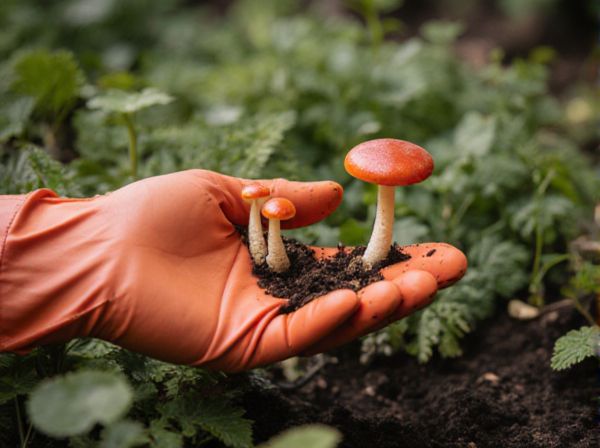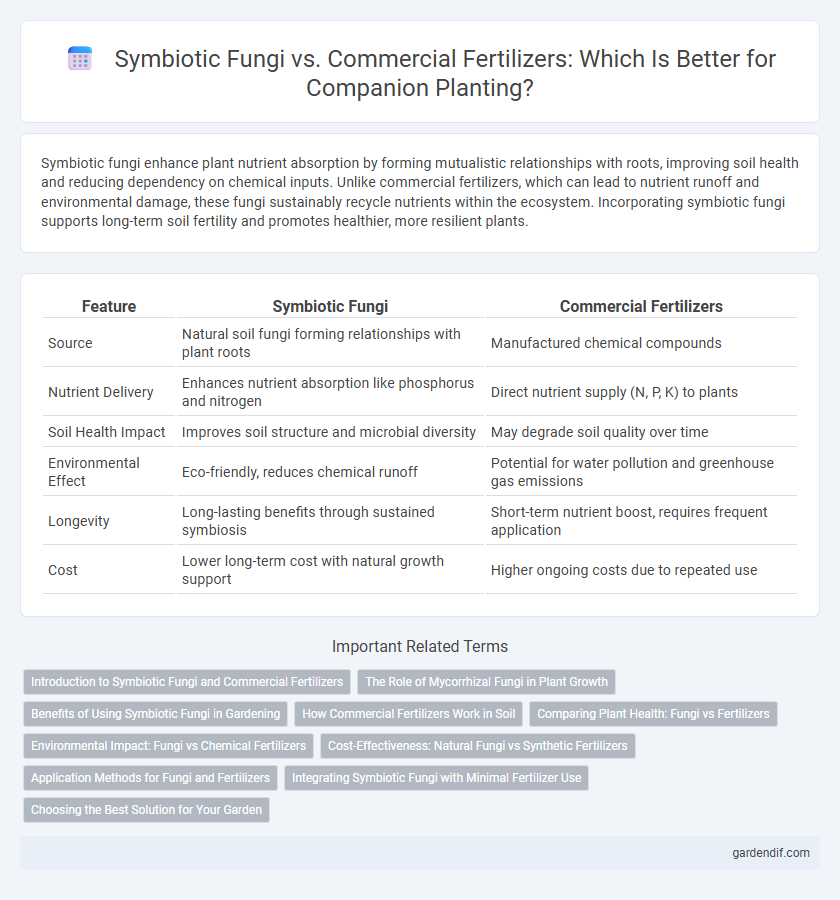
Symbiotic fungi vs commercial fertilizers Illustration
Symbiotic fungi enhance plant nutrient absorption by forming mutualistic relationships with roots, improving soil health and reducing dependency on chemical inputs. Unlike commercial fertilizers, which can lead to nutrient runoff and environmental damage, these fungi sustainably recycle nutrients within the ecosystem. Incorporating symbiotic fungi supports long-term soil fertility and promotes healthier, more resilient plants.
Table of Comparison
| Feature | Symbiotic Fungi | Commercial Fertilizers |
|---|---|---|
| Source | Natural soil fungi forming relationships with plant roots | Manufactured chemical compounds |
| Nutrient Delivery | Enhances nutrient absorption like phosphorus and nitrogen | Direct nutrient supply (N, P, K) to plants |
| Soil Health Impact | Improves soil structure and microbial diversity | May degrade soil quality over time |
| Environmental Effect | Eco-friendly, reduces chemical runoff | Potential for water pollution and greenhouse gas emissions |
| Longevity | Long-lasting benefits through sustained symbiosis | Short-term nutrient boost, requires frequent application |
| Cost | Lower long-term cost with natural growth support | Higher ongoing costs due to repeated use |
Introduction to Symbiotic Fungi and Commercial Fertilizers
Symbiotic fungi, such as mycorrhizae, form mutualistic relationships with plant roots, enhancing nutrient uptake and improving soil health through natural biological processes. Commercial fertilizers supply essential nutrients like nitrogen, phosphorus, and potassium directly to plants but often lack the long-term soil enrichment provided by symbiotic fungi. Understanding the balance between these natural and chemical inputs is crucial for sustainable agriculture and optimized crop yields.
The Role of Mycorrhizal Fungi in Plant Growth
Mycorrhizal fungi establish symbiotic relationships with plant roots, enhancing nutrient absorption, particularly phosphorus, which commercial fertilizers often fail to supply sustainably. These fungi improve soil structure and increase resistance to pathogens, promoting healthier and more resilient plant growth. Unlike commercial fertilizers, mycorrhizal fungi contribute to long-term soil fertility by fostering natural nutrient cycles essential for sustainable agriculture.
Benefits of Using Symbiotic Fungi in Gardening
Symbiotic fungi enhance soil nutrient absorption by forming mutualistic relationships with plant roots, increasing phosphorus and nitrogen uptake naturally. These fungi improve soil structure and water retention, promoting healthier plant growth without the risk of chemical runoff associated with commercial fertilizers. Use of symbiotic fungi supports sustainable gardening practices by boosting microbial diversity and reducing dependency on synthetic inputs.
How Commercial Fertilizers Work in Soil
Commercial fertilizers deliver concentrated nutrients like nitrogen, phosphorus, and potassium directly to the soil, promoting rapid plant growth by replenishing essential minerals. These fertilizers dissolve quickly, making nutrients immediately available but often leading to leaching and reduced soil microbial diversity over time. Unlike symbiotic fungi, commercial fertilizers do not enhance soil structure or biological activity, potentially causing long-term soil degradation.
Comparing Plant Health: Fungi vs Fertilizers
Symbiotic fungi enhance plant health by improving nutrient uptake, boosting resistance to pests and diseases, and promoting robust root systems through natural mycorrhizal networks. Commercial fertilizers provide immediate nutrient availability but can lead to soil degradation and reduced microbial diversity over time, negatively impacting long-term plant vitality. Studies show plants associated with symbiotic fungi exhibit greater resilience and sustained growth compared to those relying solely on chemical fertilizers.
Environmental Impact: Fungi vs Chemical Fertilizers
Symbiotic fungi enhance soil health by improving nutrient cycling and reducing the need for chemical inputs, resulting in lower greenhouse gas emissions and decreased water pollution. Chemical fertilizers often lead to soil degradation, nutrient runoff, and increased carbon footprint due to energy-intensive production processes. Integrating symbiotic fungi in agriculture promotes sustainable soil ecosystems and mitigates the negative environmental impacts associated with synthetic fertilizers.
Cost-Effectiveness: Natural Fungi vs Synthetic Fertilizers
Symbiotic fungi enhance plant nutrient uptake by forming natural mycorrhizal associations, significantly reducing the need for costly synthetic fertilizers. Commercial fertilizers often require repeated applications and can incur high expenses due to chemical manufacturing and environmental mitigation. Utilizing natural fungi offers a sustainable, cost-effective alternative that improves soil health and long-term crop productivity without the financial burden of synthetic inputs.
Application Methods for Fungi and Fertilizers
Symbiotic fungi are applied through soil inoculation, seed coating, or root dip techniques, promoting nutrient absorption and enhancing soil microbiome health. Commercial fertilizers are typically administered via granular spreading, liquid injection, or foliar spraying, providing immediate but often short-lived nutrient availability. The targeted delivery of fungi establishes long-term soil fertility, whereas fertilizers require repeated application to maintain nutrient levels.
Integrating Symbiotic Fungi with Minimal Fertilizer Use
Integrating symbiotic fungi with minimal fertilizer use enhances nutrient uptake efficiency by establishing mycorrhizal networks that improve phosphorus and nitrogen absorption in crops. This approach reduces dependency on commercial fertilizers, lowering environmental runoff and improving soil health through natural microbial activity. Combining targeted low-dose fertilizers with symbiotic fungi supports sustainable agriculture while maintaining high crop yields.
Choosing the Best Solution for Your Garden
Symbiotic fungi enhance soil health by improving nutrient absorption and promoting sustainable plant growth, whereas commercial fertilizers provide immediate but temporary nutrient boosts. Selecting the best solution depends on your garden's long-term goals, soil condition, and environmental impact preferences. Integrating symbiotic fungi can reduce chemical dependency and foster a resilient ecosystem, while commercial fertilizers may be suited for rapid growth in nutrient-depleted soils.
Symbiotic fungi vs commercial fertilizers Infographic

 gardendif.com
gardendif.com